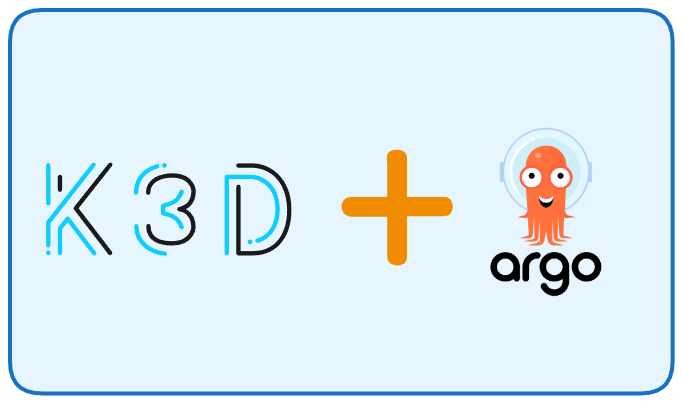K3D: Getting Started with ArgoCD

K3D: Getting Started with ArgoCD
Intro
ArgoCD is a GitOps tool with a straightforward but powerful objective: to declaratively deploy applications to Kubernetes by managing application resources directly from version control systems, such as Git repositories. Every commit to the repository represents a change, which ArgoCD can apply to the Kubernetes cluster either manually or automatically. This approach ensures that deployment processes are fully controlled through version-controlled files, fostering an explicit and auditable release process.
For example, releasing a new application version involves updating the image tag in the resource files and committing the changes to the repository. ArgoCD syncs with the repository and seamlessly deploys the new version to the cluster.
Since ArgoCD itself operates on Kubernetes, it is straightforward to set up and integrates seamlessly with lightweight Kubernetes distributions like K3s. In this tutorial, we will demonstrate how to configure a local Kubernetes cluster using K3D and deploy applications with ArgoCD, utilizing the argocd-example-apps repository as a practical example.
Prerequisites
Before we begin, ensure you have the following installed:
- Docker
- Kubectl
- K3D
- ArgoCD CLI
Step 1: Set Up a K3D Cluster
Create a new Kubernetes cluster using K3D:
$ k3d cluster create argocluster --agents 2
INFO[0000] Prep: NetworkINFO[0000] Created network 'k3d-argocluster'INFO[0000] Created image volume k3d-argocluster-imagesINFO[0000] Starting new tools node...INFO[0000] Starting node 'k3d-argocluster-tools'INFO[0001] Creating node 'k3d-argocluster-server-0'INFO[0001] Creating node 'k3d-argocluster-agent-0'INFO[0001] Creating node 'k3d-argocluster-agent-1'INFO[0001] Creating LoadBalancer 'k3d-argocluster-serverlb'INFO[0001] Using the k3d-tools node to gather environment informationINFO[0001] HostIP: using network gateway 172.18.0.1 addressINFO[0001] Starting cluster 'argocluster'INFO[0001] Starting servers...INFO[0002] Starting node 'k3d-argocluster-server-0'INFO[0009] Starting agents...INFO[0009] Starting node 'k3d-argocluster-agent-0'INFO[0009] Starting node 'k3d-argocluster-agent-1'INFO[0017] Starting helpers...INFO[0017] Starting node 'k3d-argocluster-serverlb'INFO[0024] Injecting records for hostAliases (incl. host.k3d.internal) and for 4 network members into CoreDNS configmap...INFO[0026] Cluster 'argocluster' created successfully!INFO[0026] You can now use it like this:kubectl cluster-infoVerify that your cluster is running:
$ kubectl get nodes
NAME STATUS ROLES AGE VERSIONk3d-argocluster-agent-0 Ready <none> 63s v1.30.4+k3s1k3d-argocluster-agent-1 Ready <none> 62s v1.30.4+k3s1k3d-argocluster-server-0 Ready control-plane,master 68s v1.30.4+k3s1Step 2: Install ArgoCD
Install ArgoCD in your K3D cluster:
$ kubectl create namespace argocd
$ kubectl apply -n argocd -f https://raw.githubusercontent.com/argoproj/argo-cd/stable/manifests/install.yaml
customresourcedefinition.apiextensions.k8s.io/applications.argoproj.io createdcustomresourcedefinition.apiextensions.k8s.io/applicationsets.argoproj.io createdcustomresourcedefinition.apiextensions.k8s.io/appprojects.argoproj.io createdserviceaccount/argocd-application-controller createdserviceaccount/argocd-applicationset-controller createdserviceaccount/argocd-dex-server createdserviceaccount/argocd-notifications-controller createdserviceaccount/argocd-redis createdserviceaccount/argocd-repo-server createdserviceaccount/argocd-server createdrole.rbac.authorization.k8s.io/argocd-application-controller createdrole.rbac.authorization.k8s.io/argocd-applicationset-controller createdrole.rbac.authorization.k8s.io/argocd-dex-server createdrole.rbac.authorization.k8s.io/argocd-notifications-controller createdrole.rbac.authorization.k8s.io/argocd-redis createdrole.rbac.authorization.k8s.io/argocd-server created...Check the status of ArgoCD pods:
$ kubectl get pods -n argocd
NAME READY STATUS RESTARTS AGEargocd-application-controller-0 1/1 Running 0 29margocd-applicationset-controller-684cd5f5cc-78cc8 1/1 Running 0 29margocd-dex-server-77c55fb54f-bw956 1/1 Running 0 29margocd-notifications-controller-69cd888b56-g7z4r 1/1 Running 0 29margocd-redis-55c76cb574-72mdh 1/1 Running 0 29margocd-repo-server-584d45d88f-2mdlc 1/1 Running 0 29margocd-server-8667f8577-prx6s 1/1 Running 0 29mExpose the ArgoCD API server locally, then try to accessing the dashboard:
$ kubectl port-forward svc/argocd-server -n argocd 8080:443
Step 3: Configure ArgoCD
Log in to ArgoCD
Retrieve the initial admin password:
kubectl get secret argocd-initial-admin-secret -n argocd -o jsonpath="{.data.password}" | base64 -dLog in using the admin username and the password above.

Connect a Git Repository
Just clone the argocd-example-apps repository:
git clone https://github.com/argoproj/argocd-example-apps.gitSpecify the ArgoCD server address in your CLI configuration:
$ argocd login localhost:8080
WARNING: server certificate had error: tls: failed to verify certificate: x509: certificate signed by unknown authority. Proceed insecurely (y/n)? yUsername: adminPassword:'admin:login' logged in successfullyContext 'localhost:8080' updatedCreate a new ArgoCD application using the repository:
$ $ argocd app create example-app \ --repo https://github.com/argoproj/argocd-example-apps.git \ --path ./guestbook \ --dest-server https://kubernetes.default.svc \ --dest-namespace default
application 'example-app' createdSync the application:
$ argocd app sync example-app
TIMESTAMP GROUP KIND NAMESPACE NAME STATUS HEALTH HOOK MESSAGE2025-01-10T11:31:11+07:00 Service default guestbook-ui OutOfSync Missing2025-01-10T11:31:11+07:00 apps Deployment default guestbook-ui OutOfSync Missing2025-01-10T11:31:11+07:00 Service default guestbook-ui Synced Healthy2025-01-10T11:31:11+07:00 Service default guestbook-ui Synced Healthy service/guestbook-ui created2025-01-10T11:31:11+07:00 apps Deployment default guestbook-ui OutOfSync Missing deployment.apps/guestbook-ui created2025-01-10T11:31:11+07:00 apps Deployment default guestbook-ui Synced Progressing deployment.apps/guestbook-ui created...Step 4: Verify the Deployment
Check that the application is deployed successfully:
$ kubectl get pods
NAME READY STATUS RESTARTS AGEguestbook-ui-649789b49c-zwjt8 1/1 Running 0 5m36sAccess the deployed application by exposing it via a NodePort or LoadBalancer:
$ kubectl port-forward svc/guestbook-ui 8081:80
Forwarding from 127.0.0.1:8081 -> 80Forwarding from [::1]:8081 -> 80


Conclusion
In this tutorial, you’ve set up a local Kubernetes cluster using K3D and deployed applications with ArgoCD. This setup provides a simple and powerful way to practice GitOps workflows locally. By leveraging tools like ArgoCD, you can ensure your deployments are consistent, auditable, and declarative. Happy GitOps-ing!
References
- GitOps on a Laptop with K3D and ArgoCD. https://www.sokube.io/en/blog/gitops-on-a-laptop-with-k3d-and-argocd-en.
- Take Argo CD for a spin with K3s and k3d. https://www.bekk.christmas/post/2020/13/take-argo-cd-for-a-spin-with-k3s-and-k3d.
- Application Deploy to Kubernetes with Argo CD and K3d. https://yashguptaa.medium.com/application-deploy-to-kubernetes-with-argo-cd-and-k3d-8e29cf4f83ee